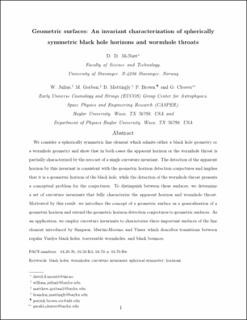Geometric surfaces: An invariant characterization of spherically symmetric black hole horizons and wormhole throats
McNutt, David Duncan; Julius, William; Gorban, Matthew; Mattingly, Brandon; Brown, Patrick; Cleaver, Gerald
Peer reviewed, Journal article
Accepted version
Permanent lenke
https://hdl.handle.net/11250/3053171Utgivelsesdato
2021Metadata
Vis full innførselSamlinger
Originalversjon
McNutt, D. D., Julius, W., Gorban, M., Mattingly, B., Brown, P., & Cleaver, G. (2021). Geometric surfaces: An invariant characterization of spherically symmetric black hole horizons and wormhole throats. Physical Review D, 103(12), 124024. 10.1103/PhysRevD.103.124024Sammendrag
We consider a spherically symmetric line element which admits either a black hole geometry or a wormhole geometry and show that in both cases the apparent horizon or the wormhole throat is partially characterized by the zero set of a single curvature invariant. The detection of the apparent horizon by this invariant is consistent with the geometric horizon detection conjectures and implies that it is a geometric horizon of the black hole, while the detection of the wormhole throat presents a conceptual problem for the conjectures. To distinguish between these surfaces, we determine a set of curvature invariants that fully characterize the apparent horizon and wormhole throat. Motivated by this result, we introduce the concept of a geometric surface as a generalization of a geometric horizon and extend the geometric horizon detection conjectures to geometric surfaces. As an application, we employ curvature invariants to characterize three important surfaces of the line element introduced by Simpson, Martin-Moruno, and Visser, which describes transitions between regular Vaidya black holes, traversable wormholes, and black bounces.
